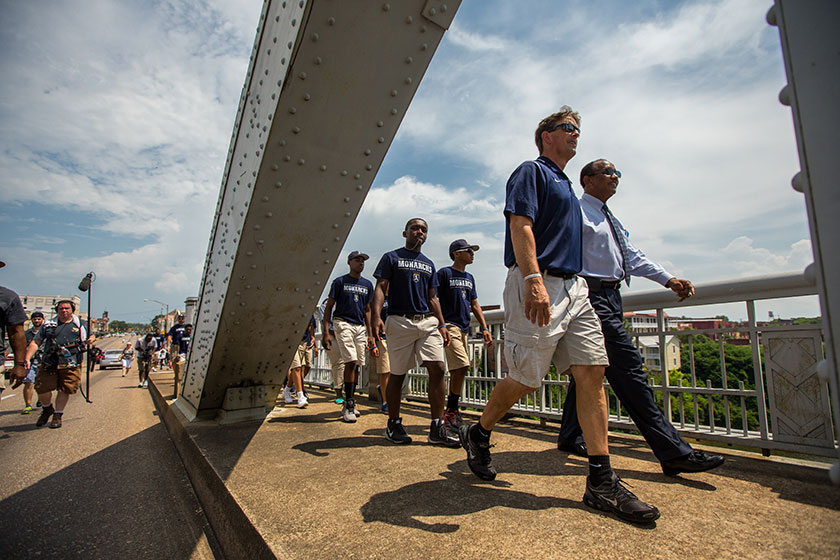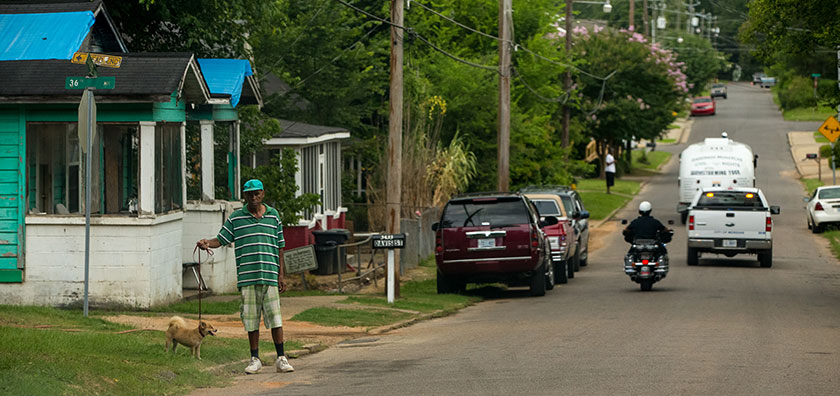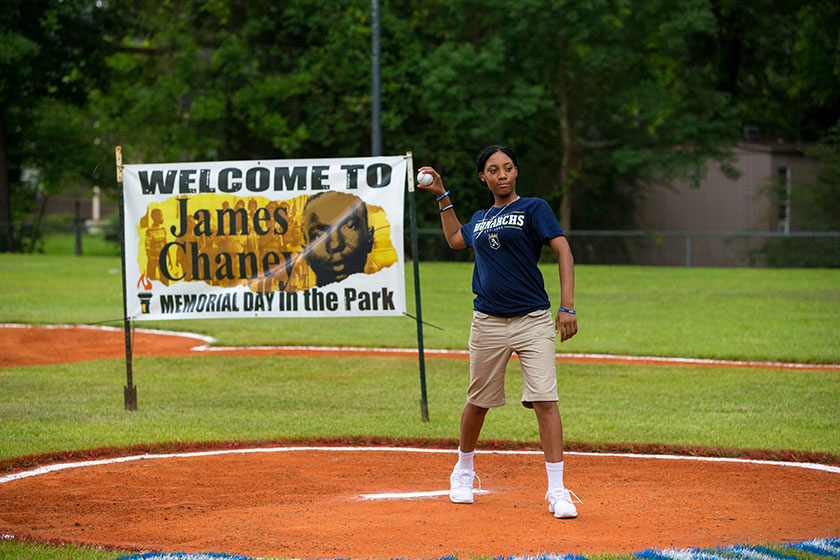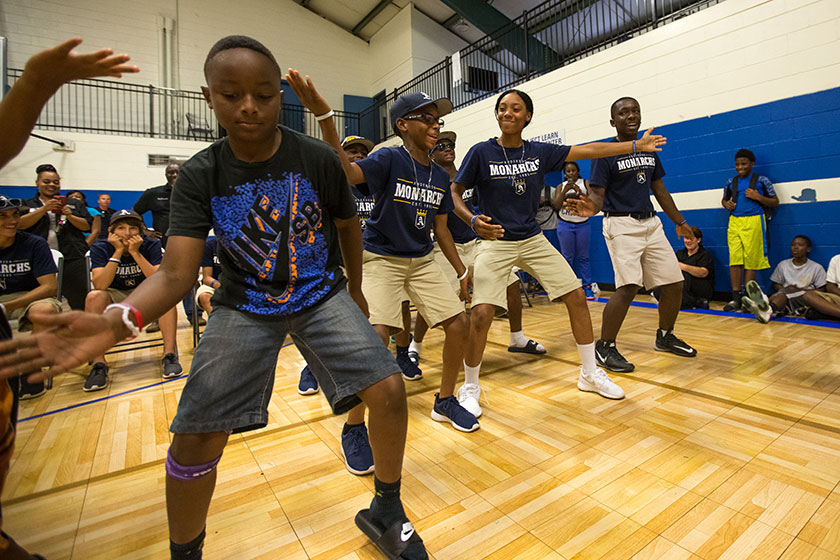Selma: The Future Remembers, the Present Forgets
Friday Morning June 26.
Day 10 of the Anderson Monarchs Civil Rights Barnstorming Trip.
This was essentially a travel day (a five hour drive from Montgomery, Alabama to Jackson, Mississippi) broken up by four stops.

The first was the Edmund Pettus Bridge in Selma, Alabama. A simple arch bridge that connects Business Route 80 across the Alabama River, the downslope on the southwest side was the scene of a violent attack on peaceful voting rights protesters on March 7, 1965. Known as Bloody Sunday, the march was meant to end in Montgomery, Alabama, but a line of armed police met the marchers, and attacked them unprovoked. The still images of the marchers being beaten and tear gassed were vital to creating awareness of the abuse of power, and unfair rules, that limited the black communities' right to vote.

I was only two when this occurred, but my memories of this event and other civil rights issues come directly from the books my parents had at home. Photo anthologies by Life and Look magazine, and the AP, were always on our coffee table, and I flipped through them countless times as an adolescent and teen. I would stare at the pictures and see something new in them each time I picked up the book. It was, however, like looking at images from another world, because the area where I grew up, and the schools I attended, were incredibly devoid of diversity.
My interest in photography was camera-driven at first. My dad always had the latest gadget camera, and took only family snapshots. At fifteen I got a camera, a black Canon AE-1, for my birthday, and started experimenting beyond snapshots. I was drawn to sports for several reasons. Beyond the desire to recreate the images I saw and cut out of Sports Illustrated, I was fascinated by how hard it was to compose and focus a long lens. I spent most of my time photographing my friends playing baseball. I guess once I stopped playing baseball myself, I had to find another challenge related to the game.
I did not really have a journalistic mentor until December 1986 when I went to work for The Philadelphia Inquirer Neighbors bureau. Dan Miller was the Delaware County bureau chief, and began to teach me about storytelling, lens selection and composition. Neighbors was a zoned edition of the paper that published three times a week, but covered a ton of sports. During football season it was not unusual for someone to shoot parts of five games in a weekend.
More importantly, Dan pushed me to shoot features, and eventually stories. I loved the eighteen months I worked as a stringer at Neighbors, but working for a paper was simply not on my radar at the time. I was driven to shoot sports, with the clear intention of working at Sports Illustrated. While I would never trade my time at SI for anything, I do wish at times I had worked on more meaningful stories. Sports is like the toy department of life, and I always felt a twinge of regret at not having worked for a paper. But, I followed my heart at the time.
Before the walk across the bridge, the Monarchs and their families spent time in the Selma Interpretive Center. There were displays, and large murals of the events that unfolded in Selma.
 Myles Eaddy appears to stare down the brutal Sheriff James Gardner Clark at a display of clubs used on the marchers
Myles Eaddy appears to stare down the brutal Sheriff James Gardner Clark at a display of clubs used on the marchers
The first time the Monarchs crossed the bridge, in the same direction the original marchers walked, the group was surrounded by media. Every image seemed to have some part of the cocoon of cameramen and sound boom poles surrounding the players. After a short stop in a small memorial park on the other side, the team was convinced to recross the bridge on foot. They did so completely unaccompanied by any media, and when bus driver Jay McGhee drove the bus alongside them, it made for the nice frame above, of Zion Spearman and Alex Johnson leading the team.

The second stop was an Arts Center in Selma, where the Monarchs were served lunch and met some young children from town. I'm not sure how well the kids knew the team, or even Mo'ne, but the parents made sure to prod them to seek out autographs of the players and get their picture taken with Mo'ne.



The third stop was a police-escorted venture into Meridian, MS. We were driven to a field that looked like it had just been completed. The field was meticulously lined, with a sign behind the mound that read Welcome to James Chaney Memorial Day at the Park. Chaney was one of three civil rights protesters murdered during Freedom Summer by the Ku Klux Klan near Philadelphia, Mississippi. The three men, Chaney, Andrew Goodman and Michael Schwerner, had their surnames spray painted on the field. Then things got weird. First of all there were no local players at the field, only parents. During the ceremony there was no mention of Goodman, Schwerner or even Chaney, and a representative for the mayor read a proclamation that made this Mo'ne Davis Day in Meridian.
The Monarchs, lined up along the third base line watched in silence, and when Mo'ne was called up to receive her Certificate, she appeared very uncomfortable for being singled out. Having her throw out the first pitch in front of the James Chaney sign was the ultimate irony.

As she posed for pictures, a long thick branch came crashing out of a tree behind the gathered group, narrowly missing a small girl. None of the parents flinched, and the picture taking continued. It's a testament to the impact Mo'ne had on people, and people's take on celebrity, that there is an absolute frenzy to have a picture taken with her.
I don't think anyone is under the delusion that Mo'ne's fame has no impact on this trip. But Monarchs head coach Steve Bandura works very hard to make this about the Civil Rights Tour and the process and importance of being a Monarch. The whole situation was cut short by a coming thunderstorm and the police escort led the bus to a local Boys and Girls Club.
Here the team was seated across from a large group of kids, and the speakers message was much more about teamwork and the tour the Monarchs were making. It was clear someone had realized their "mistake" at the park!


As the session wound down the speaker said the players would be sent off by what the kids at the center did best: dancing. A group of children was brought forward and stood in front of the Monarchs and started dancing when the music kicked in. A group of Monarchs got up and joined in, and it was a genuinely authentic moment of fun....until the speaker shooed the little kids back to their seats, leaving the embarrassed Monarchs dancing alone. They quickly sat down, and the moment was lost.
I'm reading the Matheny Manifesto right now, a book by St. Louis Cardinals manager Mike Matheny about his experience as a youth baseball coach. Much of the book talks about how parents ruin the game for kids. I'm sure some day when the young Monarchs have families of their own, they will realize how truly fortunate they were to be part of this program.
We returned to the bus and drove to Jackson, MS.
